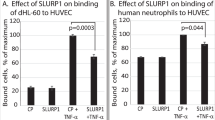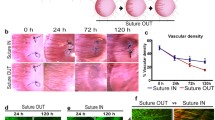Abstract
Anthrax protective antigen (PA) is a potent inhibitor of pathological angiogenesis with an unknown mechanism. In anthrax intoxication, PA interacts with capillary morphogenesis gene 2 (CMG2) and tumor endothelial marker 8 (TEM8). Here, we show that CMG2 mediates the antiangiogenic effects of PA and is required for growth-factor-induced chemotaxis. Using specific inhibitors of CMG2 and TEM8 interaction with natural ligand, as well as mice with the CMG2 or TEM8 transmembrane and intracellular domains disrupted, we demonstrate that inhibiting CMG2, but not TEM8 reduces growth-factor-induced angiogenesis in the cornea. Furthermore, the antiangiogenic effect of PA was abolished when the CMG2, but not the TEM8, gene was disrupted. Binding experiments demonstrated a broad ligand specificity for CMG2 among extracellular matrix (ECM) proteins. Ex vivo experiments demonstrated that CMG2 (but not TEM8) is required for PA activity in human dermal microvascular endothelial cell (HMVEC-d) network formation assays. Remarkably, blocking CMG2-ligand binding with PA or CRISPR knockout abolishes endothelial cell chemotaxis but not chemokinesis in microfluidic migration assays. These effects are phenocopied by Rho inhibition. Because CMG2 mediates the chemotactic response of endothelial cells to peptide growth factors in an ECM-dependent fashion, CMG2 is well-placed to integrate growth factor and ECM signals. Thus, CMG2 targeting is a novel way to inhibit angiogenesis.






Similar content being viewed by others
Data availability
The datasets generated during and/or analyzed during the current study are available from the corresponding author on reasonable request.
References
Folkman J (2007) Angiogenesis: an organizing principle for drug discovery? Nat Rev Drug Discov 6(4):273–286. https://doi.org/10.1038/nrd2115
Blanco R, Gerhardt H (2013) VEGF and Notch in tip and stalk cell selection. Cold Spring Harb Perspect Med 3(1):a006569. https://doi.org/10.1101/cshperspect.a006569
Kretschmer M, Rudiger D, Zahler S (2021) Mechanical aspects of angiogenesis. Cancers (Basel). https://doi.org/10.3390/cancers13194987
Rogers MS, Christensen KA, Birsner AE, Short SM, Wigelsworth DJ, Collier RJ, D’Amato RJ (2007) Mutant anthrax toxin B moiety (protective antigen) inhibits angiogenesis and tumor growth. Cancer Res 67(20):9980–9985. https://doi.org/10.1158/0008-5472.CAN-07-0829
Moayeri M, Wiggins JF, Leppla SH (2007) Anthrax protective antigen cleavage and clearance from the blood of mice and rats. Infect Immun 75(11):5175–5184. https://doi.org/10.1128/IAI.00719-07
Wigelsworth DJ, Krantz BA, Christensen KA, Lacy DB, Juris SJ, Collier RJ (2004) Binding stoichiometry and kinetics of the interaction of a human anthrax toxin receptor, CMG2, with protective antigen. J Biol Chem 279(22):23349–23356
Liu S, Crown D, Miller-Randolph S, Moayeri M, Wang H, Hu H, Morley T, Leppla SH (2009) Capillary morphogenesis protein-2 is the major receptor mediating lethality of anthrax toxin in vivo. Proc Natl Acad Sci USA 106(30):12424–12429
Jia Z, Ackroyd C, Han T, Agrawal V, Liu Y, Christensen K, Dominy B (2017) Effects from metal ion in tumor endothelial marker 8 and anthrax protective antigen: BioLayer Interferometry experiment and molecular dynamics simulation study. J Comput Chem 38(15):1183–1190. https://doi.org/10.1002/jcc.24768
Bradley KA, Mogridge J, Mourez M, Collier RJ, Young JAT (2001) Identification of the cellular receptor for anthrax toxin. Nature 414(6860):225–229. https://doi.org/10.1038/n35101999
Liu S, Zhang Y, Hoover B, Leppla SH (2012) The receptors that mediate the direct lethality of anthrax toxin. Toxins (Basel) 5(1):1–8. https://doi.org/10.3390/toxins5010001
Wycoff K, Maclean J, Belle A, Yu L, Tran Y, Roy C, Hayden F (2015) Anti-infective immunoadhesins from plants. Plant Biotechnol J 13(8):1078–1093. https://doi.org/10.1111/pbi.12441
Wycoff KL, Belle A, Deppe D, Schaefer L, Maclean JM, Haase S, Trilling AK, Liu S, Leppla SH, Geren IN, Pawlik J, Peterson JW (2011) Recombinant anthrax toxin receptor-Fc fusion proteins produced in plants protect rabbits against inhalational anthrax. Antimicrob Agents Chemother 55(1):132–139. https://doi.org/10.1128/AAC.00592-10
Burgi J, Kunz B, Abrami L, Deuquet J, Piersigilli A, Scholl-Burgi S, Lausch E, Unger S, Superti-Furga A, Bonaldo P, van der Goot FG (2017) CMG2/ANTXR2 regulates extracellular collagen VI which accumulates in hyaline fibromatosis syndrome. Nat Commun 8:15861. https://doi.org/10.1038/ncomms15861
Chaudhary A, Hilton MB, Seaman S, Haines DC, Stevenson S, Lemotte PK, Tschantz WR, Zhang XM, Saha S, Fleming T, St Croix B (2012) TEM8/ANTXR1 blockade inhibits pathological angiogenesis and potentiates tumoricidal responses against multiple cancer types. Cancer Cell 21(2):212–226. https://doi.org/10.1016/j.ccr.2012.01.004
Reeves CV, Dufraine J, Young JA, Kitajewski J (2010) Anthrax toxin receptor 2 is expressed in murine and tumor vasculature and functions in endothelial proliferation and morphogenesis. Oncogene 29(6):789–801
Peters DE, Zhang Y, Molinolo AA, Miller-Randolph S, Szabo R, Bugge TH, Leppla SH, Liu S (2012) Capillary morphogenesis protein-2 is required for mouse parturition by maintaining uterine collagen homeostasis. Biochem Biophys Res Commun 422(3):393–397. https://doi.org/10.1016/j.bbrc.2012.04.160
Cryan LM, Bazinet L, Habeshian KA, Cao S, Clardy J, Christensen KA, Rogers MS (2013) 1,2,3,4,6-penta-O-galloyl-beta-d-glucopyranose Inhibits angiogenesis via inhibition of capillary morphogenesis gene 2. J Med Chem 56(5):1940–1945. https://doi.org/10.1021/jm301558t
Gd E, Carrero P, Madrona A, Rodriguez-Salamanca P, Martinez-Gualda B, Camarasa MJ, Jimeno ML, Bennallack PR, Finnell JG, Tsang TM, Christensen KA, San-Felix A, Rogers MS (2019) Galloyl carbohydrates with antiangiogenic activity mediated by capillary morphogenesis gene 2 (CMG2) protein binding. J Med Chem 62(8):3958–3970. https://doi.org/10.1021/acs.jmedchem.8b01988
Finnell JG, Tsang TM, Cryan L, Garrard S, Lee SL, Ackroyd PC, Rogers MS, Christensen KA (2020) A canstatin-derived peptide provides insight into the role of capillary morphogenesis gene 2 in angiogenic regulation and matrix uptake. ACS Chem Biol 15(2):587–596. https://doi.org/10.1021/acschembio.0c00064
Rogers MS, Cryan LM, Habeshian KA, Bazinet L, Caldwell TP, Ackroyd PC, Christensen KA (2012) A FRET-based high throughput screening assay to identify inhibitors of anthrax protective antigen binding to capillary morphogenesis gene 2 protein. PLoS ONE 7(6):e39911. https://doi.org/10.1371/journal.pone.0039911
Cao S, Cryan L, Habeshian KA, Murillo C, Tamayo-Castillo G, Rogers MS, Clardy J (2012) Phenolic compounds as antiangiogenic CMG2 inhibitors from Costa Rican endophytic fungi. Bioorg Med Chem Lett 22(18):5885–5888. https://doi.org/10.1016/j.bmcl.2012.07.075
Lacy DB, Wigelsworth DJ, Scobie HM, Young JAT, Collier RJ (2004) Crystal structure of the von Willebrand factor A domain of human capillary morphogenesis protein 2: an anthrax toxin receptor. P Natl Acad Sci USA 101(17):6367–6372. https://doi.org/10.1073/pnas.0401506101
Whittaker CA, Hynes RO (2002) Distribution and evolution of von Willebrand/integrin A domains: widely dispersed domains with roles in cell adhesion and elsewhere. Mol Biol Cell 13(10):3369–3387. https://doi.org/10.1091/mbc.E02-05-0259
Gao M, Schulten K (2006) Onset of anthrax toxin pore formation. Biophys J 90(9):3267–3279. https://doi.org/10.1529/biophysj.105.079376
Scobie HM, Rainey GJA, Bradley KA, Young JAT (2003) Human capillary morphogenesis protein 2 functions as an anthrax toxin receptor. Proc Natl Acad Sci USA 100(9):5170–5174. https://doi.org/10.1073/pnas.0431098100
Bell SE, Mavila A, Salazar R, Bayless KJ, Kanagala S, Maxwell SA, Davis GE (2001) Differential gene expression during capillary morphogenesis in 3D collagen matrices: regulated expression of genes involved in basement membrane matrix assembly, cell cycle progression, cellular differentiation and G-protein signaling. J Cell Sci 114(Pt 15):2755–2773
Cryan LM, Habeshian KA, Caldwell TP, Morris MT, Ackroyd PC, Christensen KA, Rogers MS (2013) Identification of small molecules that inhibit the interaction of TEM8 with anthrax protective antigen using a FRET assay. J Biomol Screen 18(6):714–725. https://doi.org/10.1177/1087057113478655
Vink JY, Charles-Horvath PC, Kitajewski JK, Reeves CV (2014) Anthrax toxin receptor 2 promotes human uterine smooth muscle cell viability, migration and contractility. Am J Obstet Gynecol 210(2):154e151-158. https://doi.org/10.1016/j.ajog.2013.09.030
Lawson CD, Ridley AJ (2018) Rho GTPase signaling complexes in cell migration and invasion. J Cell Biol 217(2):447–457. https://doi.org/10.1083/jcb.201612069
Narumiya S, Tanji M, Ishizaki T (2009) Rho signaling, ROCK and mDia1, in transformation, metastasis and invasion. Cancer Metast Rev 28(1–2):65–76. https://doi.org/10.1007/s10555-008-9170-7
Castanon I, Abrami L, Holtzer L, Heisenberg CP, van der Goot FG, Gonzalez-Gaitan M (2013) Anthrax toxin receptor 2a controls mitotic spindle positioning. Nat Cell Biol 15(1):28–39. https://doi.org/10.1038/ncb2632
Jérôme Bürgi LA, Castanon Irinka, Yan Shixu E, Luciano A, Abriata ML, Unger Sheila, Superti-Furga Andrea, Dal Peraro Matteo, Goot MGGaFGvd, (2019) A Novel talin-to-RhoA switch mechanism upon ligand binding of the collagen VI receptor CMG2. Developmental Cell. https://doi.org/10.2139/ssrn.3193408
Zahra FT, Sajib MS, Ichiyama Y, Akwii RG, Tullar PE, Cobos C, Minchew SA, Doci CL, Zheng Y, Kubota Y, Gutkind JS, Mikelis CM (2019) Endothelial RhoA GTPase is essential for in vitro endothelial functions but dispensable for physiological in vivo angiogenesis. Sci Rep 9(1):11666. https://doi.org/10.1038/s41598-019-48053-z
Burgi J, Abrami L, Castanon I, Abriata LA, Kunz B, Yan SE, Lera M, Unger S, Superti-Furga A, Peraro MD, Gaitan MG, van der Goot FG (2020) Ligand binding to the collagen VI receptor triggers a talin-to-RhoA switch that regulates receptor endocytosis. Dev Cell 53(4):418–430414. https://doi.org/10.1016/j.devcel.2020.04.015
Bayless KJ, Johnson GA (2011) Role of the cytoskeleton in formation and maintenance of angiogenic sprouts. J Vasc Res 48(5):369–385. https://doi.org/10.1159/000324751
Martin M, Veloso A, Wu J, Katrukha EA, Akhmanova A (2018) Control of endothelial cell polarity and sprouting angiogenesis by non-centrosomal microtubules. Elife. https://doi.org/10.7554/eLife.33864
Welti JC, Gourlaouen M, Powles T, Kudahetti SC, Wilson P, Berney DM, Reynolds AR (2011) Fibroblast growth factor 2 regulates endothelial cell sensitivity to sunitinib. Oncogene 30(10):1183–1193. https://doi.org/10.1038/onc.2010.503
Casanovas O, Hicklin DJ, Bergers G, Hanahan D (2005) Drug resistance by evasion of antiangiogenic targeting of VEGF signaling in late-stage pancreatic islet tumors. Cancer Cell 8(4):299–309. https://doi.org/10.1016/j.ccr.2005.09.005
Huang D, Ding Y, Zhou M, Rini BI, Petillo D, Qian CN, Kahnoski R, Futreal PA, Furge KA, Teh BT (2010) Interleukin-8 mediates resistance to antiangiogenic agent sunitinib in renal cell carcinoma. Cancer Res 70(3):1063–1071. https://doi.org/10.1158/0008-5472.CAN-09-3965
Porta C, Paglino C, Imarisio I, Ganini C, Sacchi L, Quaglini S, Giunta V, De Amici M (2013) Changes in circulating pro-angiogenic cytokines, other than VEGF, before progression to sunitinib therapy in advanced renal cell carcinoma patients. Oncology 84(2):115–122. https://doi.org/10.1159/000342099
Friedlander M (2009) Combination angiostatic therapies: targeting multiple angiogenic pathways. Retina 29(6 Suppl):S27-29. https://doi.org/10.1097/IAE.0b013e3181ad2673
Rogers MS, Birsner AE, D’Amato RJ (2007) The mouse cornea micropocket angiogenesis assay. Nat Protoc 2(10):2545–2550
Scobie HM, Rainey GJ, Bradley KA, Young JA (2003) Human capillary morphogenesis protein 2 functions as an anthrax toxin receptor. Proc Natl Acad Sci U S A 100(9):5170–5174
Lam AJ, St-Pierre F, Gong Y, Marshall JD, Cranfill PJ, Baird MA, McKeown MR, Wiedenmann J, Davidson MW, Schnitzer MJ, Tsien RY, Lin MZ (2012) Improving FRET dynamic range with bright green and red fluorescent proteins. Nat Methods 9(10):1005–1012. https://doi.org/10.1038/nmeth.2171
Golden RJ, Chen B, Li T, Braun J, Manjunath H, Chen X, Wu J, Schmid V, Chang TC, Kopp F, Ramirez-Martinez A, Tagliabracci VS, Chen ZJ, Xie Y, Mendell JT (2017) An Argonaute phosphorylation cycle promotes microRNA-mediated silencing. Nature 542(7640):197–202. https://doi.org/10.1038/nature21025
Acknowledgements
The CMG2-Fc and TEM8-Fc fusion proteins were a kind gift of Planet Biotechnology. The SR-8F7/C7 anti-CMG2 antibody and associated data were a kind gift of Gisou van der Goot and Laurence Abrami. The L2 anti-TEM8 antibody was a kind gift of Brad St. Croix. Funding was provided by the NEI (R01EY018829), NINDS (R21NS059411), and DOD CDMRP (W81XWH-08-1-0710).
Author information
Authors and Affiliations
Corresponding author
Ethics declarations
Conflict of interest
The authors declare that they have no conflict of interest.
Additional information
Publisher's Note
Springer Nature remains neutral with regard to jurisdictional claims in published maps and institutional affiliations.
Lorna M. Cryanb and Tsz-Ming Tsanga are contributed equally to this work.
Supplementary Information
Below is the link to the electronic supplementary material.
Rights and permissions
About this article
Cite this article
Cryan, L.M., Tsang, TM., Stiles, J. et al. Capillary morphogenesis gene 2 (CMG2) mediates growth factor-induced angiogenesis by regulating endothelial cell chemotaxis. Angiogenesis 25, 397–410 (2022). https://doi.org/10.1007/s10456-022-09833-w
Received:
Accepted:
Published:
Issue Date:
DOI: https://doi.org/10.1007/s10456-022-09833-w




